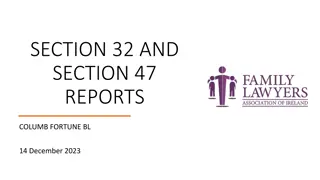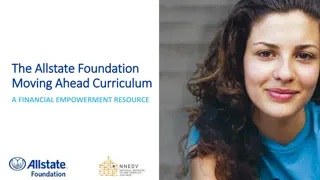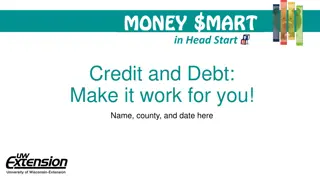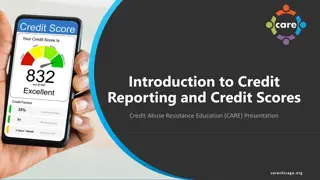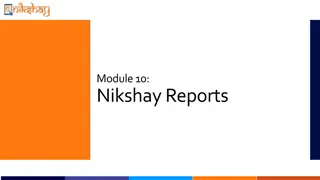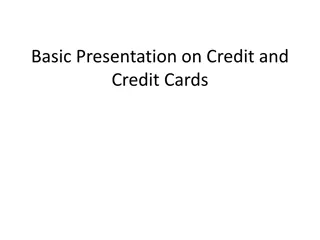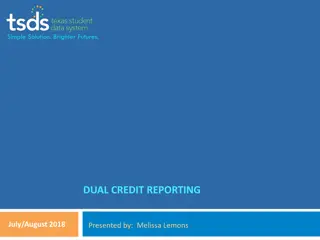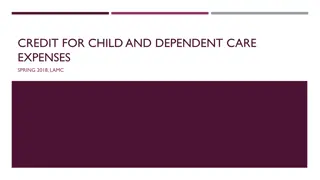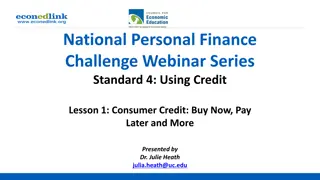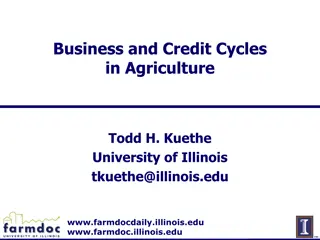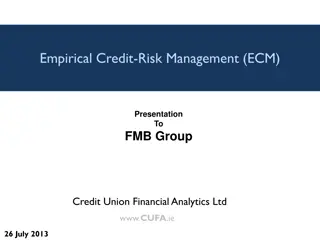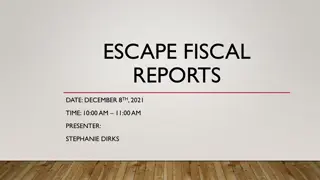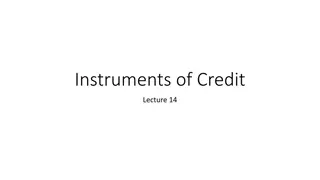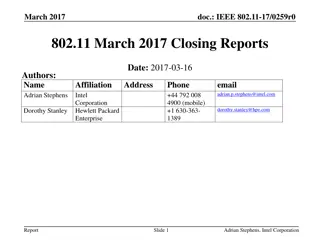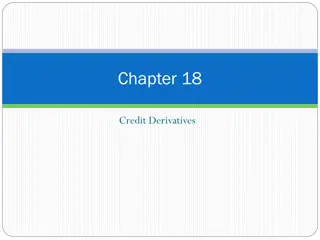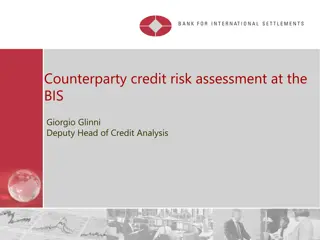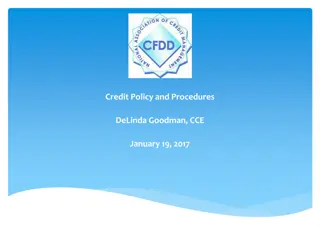Understanding Credit Reports and Building Credit in 2017
Understanding credit reports is essential for financial well-being. A credit report is a record of your payment history on loans and credit cards. This report is used to calculate your credit score, which determines your creditworthiness. Building and maintaining credit involves making payments on time, managing debt responsibly, and understanding key terms like credit score, tradeline, and public records. Knowing how credit scores are calculated based on payment history, amounts owed, length of credit history, new credit, and types of credit used is crucial for maintaining a healthy credit profile. The report discusses the three main credit bureaus - Equifax, TransUnion, and Experian - and how they compile credit information. By being aware of these concepts, individuals can take control of their credit and work towards improving it.
Download Presentation

Please find below an Image/Link to download the presentation.
The content on the website is provided AS IS for your information and personal use only. It may not be sold, licensed, or shared on other websites without obtaining consent from the author. Download presentation by click this link. If you encounter any issues during the download, it is possible that the publisher has removed the file from their server.
E N D
Presentation Transcript
2017 How is it determined? How to read a credit report? How to build and maintain credit? 1
Understanding Credit Reports What is a credit report? A credit report is simply a file that is created by the bureaus when you make a payment on loans, credit cards, student loans or other debt related items. The company that gave a customer the tradeline keeps a record of how the individual pays on the debt. This information is sent to one or all of the bureaus. The bureaus then compile the information and create a credit score. Rev 12/17 2
Understanding Credit Reports Before we jump into all things credit report related, it is important for us to know a few key terms. Terms Credit Score, Beacon, and FICO (Fair, Isaac & Co) Tradeline Open-End Credit or Revolving Line of Credit A good way to get credit started secured credit card Closed-End Credit or Installment Delinquency 30, 60, 90, 120, 180 Charge-offs Collections Rev 12/17 3
Understanding Credit Reports Terms (cont.) Public Records Bankruptcy Tax Lien Civil Judgements Rev 12/17 4
Understanding Credit Reports There are 3 main credit bureaus, also known as agencies, that receive information from creditors regarding the history of different loans, credit cards, and other debt related items. Equifax We use this bureau when pulling credit reports for accounts and consumer loan applications. TransUnion Experian www.annualcreditreport.com Pull your credit and review! Rev 12/17 5
Understanding Credit Reports What is a credit score? A credit score is a mathematical equation that takes several pieces of credit information and creates a score based off of how likely a consumer is to pay their debts in the future. FICO credit scoring uses a range of 300-850. Rev 12/17 6
Understanding Credit Reports What credit information is used to calculate the score? Payment History How has the consumer paid on the debt Amounts Owed How much does the consumer owe on their debt Length of Credit History How long have the tradelines been open New Credit How much debt have they been applying/approved for recently Types of Credit Used Revolving vs. Installment Revolving balances vs. available line Rev 12/17 7
Understanding Credit Reports Are the scores the same between the 3 bureaus? No Each bureau uses its own formula to create a score for each consumer. These differences in formulas lead to potentially different scores. Creditors may not always report to all 3 bureaus as they are not required to, thus causing scores to be different between each bureau. Can I tell a customer how long it will take before their credit score improves? No, because each bureau weighs the data that is reported differently, there is no way to tell how long it will take before their credit reaches a specific score. It will also depend on the types of credit they have within their credit report, balances of tradelines, payment history, etc. Rev 12/17 8
Understanding Credit Reports How long does it take before a consumer starts earning credit for the debt they have? To be able to accurately create a score for a consumer, the credit report must contain 6 months or more worth of information for at least 1 tradeline. What happens if I don t use any credit for a while? If a credit file stays inactive for too long then a consumer could potentially lose their credit score despite having credit history. The credit account history will still remain on the report and will be visible for a creditor to view. Rev 12/17 9
Understanding Credit Reports What are some factors that are NOT considered in a credit score? Race, color, religion, national origin, sex, and marital status. Age Salary, occupation, etc. Interest rates being charged on current debts Phone bills, utility bills, energy bills, etc. (unless they have gone delinquent and have been sent off for collection) Rev 12/17 10
Understanding Credit Reports Viewing a Credit Report This is the very top section of the credit report. The information that you see in this section is what we enter when requesting the credit report. Rev 12/17 11
Understanding Credit Reports Report Results This section has a lot of information in it. Let s break it down into smaller sections. The first area shows what the credit score is for the applicant. In this example it is a 748. It also shows the top 3-5 reasons why the customer doesn t have the best possible score. 1 2 3 4 Rev 12/17 12
Understanding Credit Reports Report Results Safescan Warnings Occasionally you will have a warning that shows on the credit report because a social security number has been issued more recently by the Social Security Administration. Rev 12/17 13
Understanding Credit Reports Report Results The following section is information regarding the consumer s previous addresses, SSN, DOB, etc. When the Equifax credit file was established. Rev 12/17 14
Understanding Credit Reports Report Results Fraud Alerts Initial Fraud is an alert that is active for 90 day. Extended Fraud is an alert that is active for 7 years. Rev 12/17 15
Understanding Credit Reports Report Results Public Records and Collections The next 2 sections of the credit report show any bankruptcies, judgments, or collection accounts that may be on the credit file. Public Records This is the date that the bankruptcy was originally filed. Rev 12/017 16
Understanding Credit Reports Report Results Public Records and Collections (cont.) Collection Accounts ECOA Code that indicates ownership of tradeline Agency ID code for that specific creditor (622YC8985 H R Accts) Client Who held the original debt Status/Serial Shows if the items is paid or unpaid List Date the debt was first reported as a collection account RPTD The last time the tradeline was reported AMT Amount that was reported ($6950) BAL How much is currently owed ($7687) DLA Date Last Active Rev 12/17 17
Understanding Credit Reports This section is where we get into the tradelines of the credit report. It is important to know what the codes mean so you know what you are looking at. Below it will break down the different line items. Firm Creditor s name Ident Code ID code for that specific creditor CS Current Status of the tradeline RPTD The last time the tradeline was reported ECOA Code that indicates ownership of tradeline Account number The credit account number OPND When the tradeline was originally opened Limit Credit limit or loan amount HICR The highest amt ever charged on the card or the original loan amt BAL$ - Amt currently owed on the account DFD/DLA Date of last activity P/Due Amt that was past due at the time the data was reported Term Monthly payment obligation Rev 12/17 18
Understanding Credit Reports The credit report will be broken into 2 different parts. You will have the revolving lines reported first, with a subtotal of all revolving debt at the end of that section. The report will then show all of the installment debt after that. It will also have a subtotal at the end of that section. At the very end of the tradeline history you will see a grand total for all debt that the customer currently has outstanding balancing on. Rev 12/17 19
Understanding Credit Reports At the end of the credit report it indicates where and when the applicant has been applying for credit. Rev 12/17 20
Understanding Credit Reports How do you get started? Deposit accounts Secured credit card account Check your credit report annually Communicate with your creditors 21
Understanding Credit Reports Jennifer Lough 319-358-6160 Rev 12/17 22


